Japanese Zen Gardens
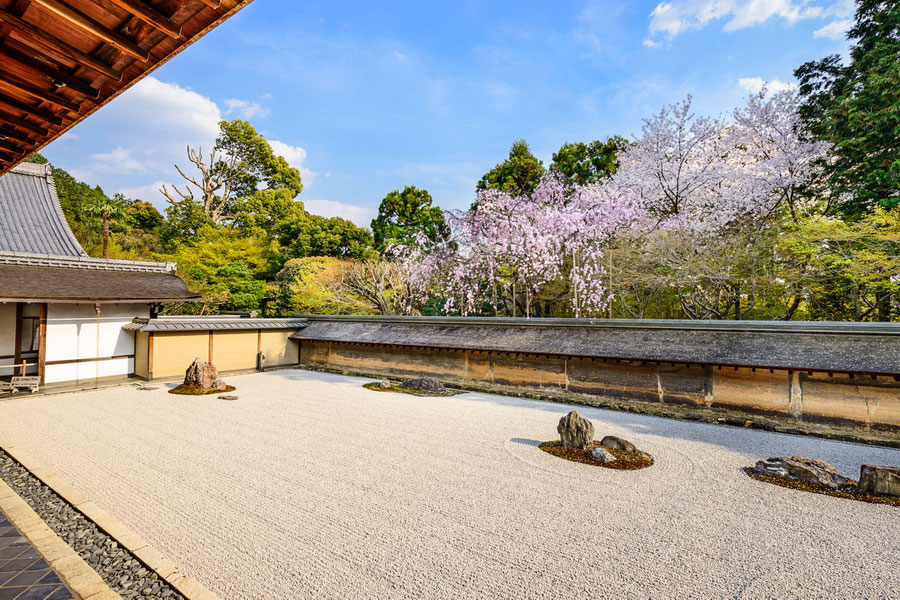
Japanese rock gardens or Zen gardens are a beautiful expression of Japanese culture. Viewers admire the mesmerizing sight of nature in its simplicity yet profound power. However, as the 20th-century English novelist Rudyard Kipling wrote: “Gardens are not made by singing ‘Oh, how beautiful‘, and sitting in the shade”. Indeed, when looking at the strategically placed stones and other aspects of Japanese traditional gardens, you realize these are expressions of human thought and effort influenced by religion and philosophy.
Origins of the Japanese Garden – Teien
Origins of the Japanese garden are apparent in the distant past through the Japanese archipelago landscape – mountains rising briskly from the sea. The unique physical structure of the country, its fauna, and flora became the basis for the garden already in prehistoric times.
The echo of Japanese gardens is first revealed in the word niwa found in the 8th-century anthology of poems – Man'yōshū (The Collection of Ten Thousand Leaves). It is typically associated with the broad open sea and the fishing grounds.
Another word in Man'yōshū is sono, likely to mean garden (bordered fields) in a portion of the poem describing plum flowers. The two, niwa and sono, are used today to refer to a garden.
And what about the most common word, "teien”? The term's origin is attributed to the different pronunciations of Japanese characters. The Japanese niwa is tei in Chinese pronunciation, and en is for sono. Instead of saying niwa-sono, the preferred utterance is teien.
These words reflect the concept of the Japanese garden we witness today, where tei or niwa is a wild territory/nature untouched by man, and en or sono is a controlled area.
The Japanese Garden Styles
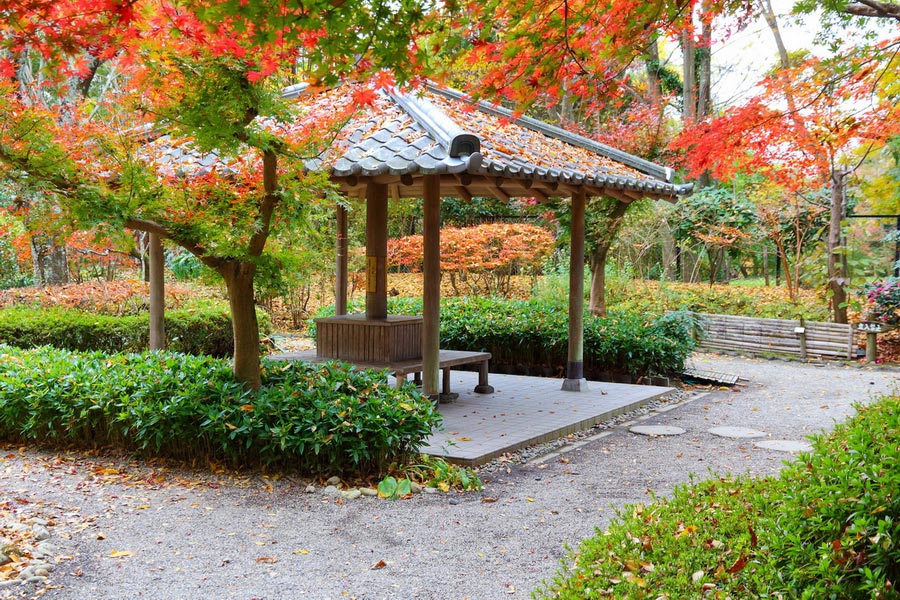
Many attractions in Japan are imperial palaces, Buddhist temples, and Shinto shrines, and they often feature captivating gardens. During ancient times, stylized gardens, such as dry gardens made of stones or serene tea gardens, provided a source of visual pleasure and entertainment, similar to the role of television in modern times. Nobles would gather in them to socialize and enjoy boat rides on ponds, and poets would find inspiration in the beautiful surroundings, crafting poems influenced by nature's beauty.
Our list invites you to become acquainted with the various main styles of Japanese gardens chronologically. The first garden in our guide represents the earliest style and period. You will not only gain knowledge about a specific garden that is worth visiting but also about its historical context and style.
Imperial Villa Garden Site in Nara
The Imperial Villa Gardens in northern Nara offer a glimpse into the pleasure gardens of emperors and nobles. They are considered pleasure gardens based on the first Japanese records of the Nihon Shoki (Chronicles of Japan) compiled in 720 AD.
One passage narrates about Emperor Keiko in 74 AD: “Putting a few carp into a pond and rejoicing while watching them morning and evening and launching”. As the story unfolds, it mentions boat strolls on the pound organized by the same emperor. Another text describes Emperor Kenzo, who lived in 486 AD: “The emperor Kenzo went into the garden and feasted at the edge of the winding stream”.
What did these pleasure gardens look like? Today’s Imperial Villa Garden site in the ancient Nara area represents a reconstruction based on scant archaeological evidence from the 8th century, discovered in the 1970s and undertaken by the Nara National Research Institute for Cultural Properties.
Unfortunately, there is no material evidence of gardens from the 2nd or 5th centuries. What is known is that by the time Nihon Shoki was published, Japan had embraced Buddhism from China via Korea in 552 AD. The Japanese rulers would send delegations to China to study Chinese gardening, writing, and architecture. Thus, the first so-called Japanese pleasure gardens, as described in the Nihon Shoki and Man'yōshū, undoubtedly copied the Chinese style of arranging gardens.
The highlight of the Imperial Garden is the large rocks along the winding pond. The three rocks inside the pond usually symbolize floating islands, while the S-shaped pond follows the form of the Yoshino River.
Pleasure Gardens – Kyuseiki and To’in
The gardens of Kyuseiki in the Nara modern city and To’in in the Imperial Palace were built in the late Nara period (710-794). Despite Chinese influence, these are manifestations of authentic Japanese gardens. One can see the difference between Chinese and Japanese versions.
Firstly, they were much smaller, less formal, and more natural variants compared to the massive and more artificial Tang Dynasty gardens. Secondly, these stream gardens were not directly vehicles of Daoism or Buddhism. Instead, they were rather meant for pure pleasure.
When you stop by the Kyuseiki Teien or To’in, give a way to your imagination and imagine tiny boats floating downstream, aristocrats drinking rice wine idly and enjoying poetry contests unrolling before them.
Water Gardens of Kyoto Imperial Palace
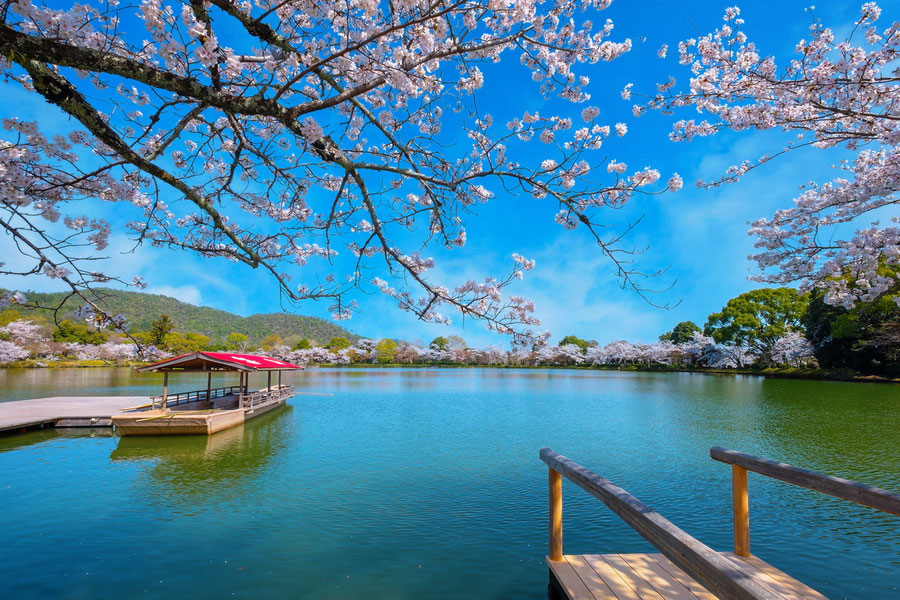
The Imperial Palace in Kyoto signifies the Heian period (794-1185), when the capital was moved to the “Eastern Capital”. Along with the gardens of villas and nobles of that time, these palace gardens are named ‘water gardens’ because they boast one or more lakes connected by bridges and twisting streams.
A replica of the 8th-century palace was constructed in Kyoto in 1895. The gardens (eastern, western, and southern) follow the Chinese Feng Shui principles. However, the teien to the south has a unique Japanese trait – a vast empty area of white sand and gravel.
The garden of Daikakuji is one of the water gardens, also known as chisen-shuyu. It was built to allow imperial court members and nobles to view the garden from a boat. It is about a 15-minute walk north of JR Saga-Arashiyama Station. Built during the reign of Emperor Saga (809-823), it resembles the Chinese garden designs of that period. A distinctive style of Japanese rock garden is seen on a hillside north of the pond or artificial lake – the oldest Japanese garden pond from the Heian period.
Paradise Garden of the Byodo-in Temple
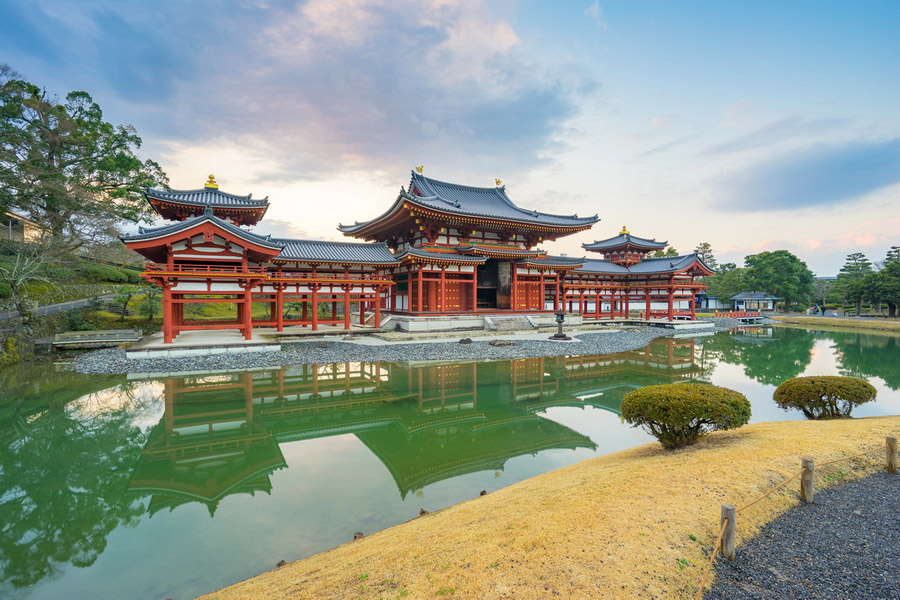
A new architectural style in garden design appeared in the late Heian period under the title “Paradise Garden” (Jodo Teien) or a “Pure Land Garden”. Amitabha Buddhist followers built one in Byodo-in Temple. The pond represents the Pure Land Paradise of Amida Buddha (Far West, the edge of the world, the lotus land), and inside the hall is the deity's statue. Members of the Fujiwara family would sit to the east across the pond in front of the Phoenix Hall, gaze west at the statue, and meditate.
Unlike pleasure gardens, it was built for prayer and meditation, but not without an emphasis on the aesthetic landscape.
Ryoan-ji Zen Garden

The Ryoan-ji Temple, located northwest of Kyoto, is about a 25-minute walk southwest of the Golden Pavilion. This is where you will find a dazzling example of the Zen garden, a Japanese dry garden. Constructed under the ruler of the Muromachi period (1185-1573) in the late 15th century, the temple and its garden are listed as UNESCO World Heritage Sites.
The Rinzai school of Zen, a new branch of Buddhism, was introduced during the Muromachi clan's reign. Shoguns (military leaders) supported this religion, as reflected in the palace and temple gardens of that time.
The garden’s hallmark is rocks surrounded by gravel. They may represent a famous mountain, boat, or animal. When grouped, the rocks may stand for a waterfall or a crane. Simplicity and modesty are the main traits of Japanese dry gardens.
Tokushima Castle Omote Goten Garden
This castle garden is nestled in the center of Tokushima on Shikoku Island, the smallest of Japan's four main islands. The building is the 1989 reconstruction of the former Tokushima mansion of the Momoyama period (1568-1600). The original was dismantled in 1845 and then destroyed during the World War II bombardments.
A 10-meter-long bridge made of two natural stones, a blanket of pebbles, and another 5-meter single-cut rock bridge over the pond garden nearby, surrounded by green trees, is an exercise in natural simplicity.
These Momoyama-style gardens were constructed for viewing from above, usually from a pavilion, and as stroll gardens with walkways providing views of artificial mountains.
Additionally, the period featured the development of tea culture. Gardens with tea houses became known as tea gardens (cha-niwa or roji), quiet places of escaping everyday routine before entering the chashitsu (tearoom).
When in Kyoto, be sure to tour the Myokian Temple. It prides itself on having the oldest tea house, Tai-an, designed by the noted tea master Sen no Rikyu during the reign of Toyotomi Hideyoshi.
The Katsura Imperial Villa Garden

The Katsura Imperial Villa and its garden in the western suburb of Kyoto were designed during the Edo Period (1615-1867). During this period, the capital moved to Edo, today's Tokyo, while Kyoto remained a cultural center of Japan.
Prince Hachijo Toshihito decided to build a villa inspired by passages in the Tales of Genji: “Far away, in the country village of Katsura, the reflection of the moon upon the water is clear and tranquil”. This was embellished with one of the most fascinating Japanese traditional promenade gardens, featuring a pond, a bridge, and tea houses. Among the most interesting items on the villa grounds is the sozu, a device to scare off wild animals.
The pavilions are simple, following the sukiya style, which was widespread at that time. The garden can be viewed from any building.
Other notable Edo-period promenade gardens include the Ritsurin Garden, the Hermitage Garden at Shisen-do, the North Garden at Ninna-ji in Kyoto, and the Koishikawa Korakuen Garden in Tokyo.
Kyu-Furukawa Gardens
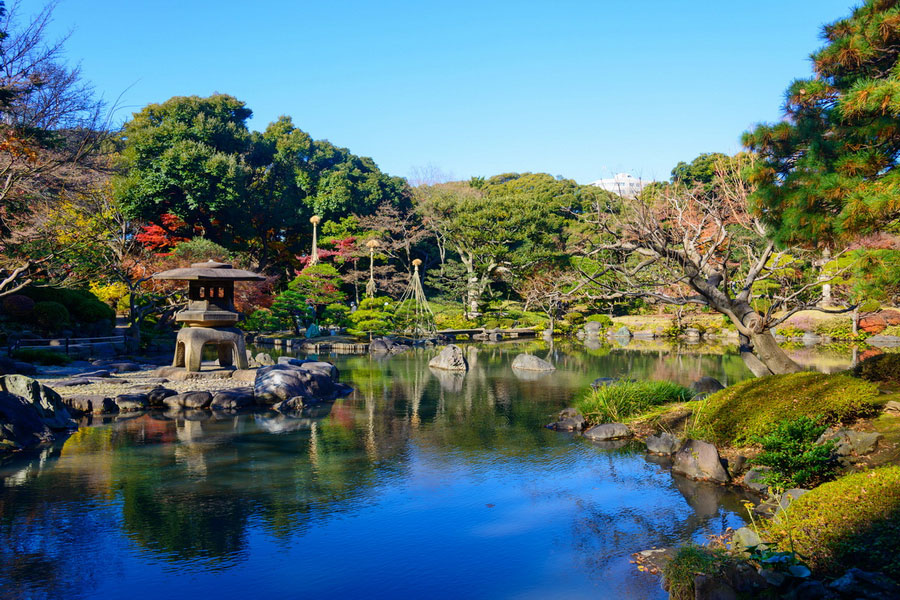
In the early 20th century, Baron Toranosuke Furukawa built an Italian-style mansion with a second floor featuring Japanese design. The pathway toward the villa at the top of the hill is framed by a French-style rose garden and a Japanese garden down the hill.
The Kyu-Furukawa Gardens in Tokyo exemplify the experimentation with the Western style during the Meiji Period (1868-1912) when the country began embracing foreign influence. The architect who laid out both the mansion and the garden, Josiah Conder, was nicknamed the “father of Japanese modern architecture”.
Tofuku-ji Gardens
Although the Tofuku-ji Temple in Kyoto was founded in the 13th century, the landscape architect Mirei Shigemori, inspired by classic models, built the four gardens on its grounds in the 1930s during the Showa period (1926-1989). It is said to have set the trend for reviving the Japanese gardening concepts in the 20th century. Vast and colorful carpets of maple tree canopies have become a major draw for tourists during the autumn foliage season. Additionally, Tofuku-ji is one of the five great Zen temples in Kyoto.
The Southern Garden is a classic Zen dry garden. The check-patterned moss garden and the Big Dipper Garden with seven stones give the impression of freshness because Mirei incorporated ideas from the classical style. All four green spaces showcase Buddhist beliefs and traditions.
A more contemporary garden is Awaji Yumebutai on the island of Awaji. When visiting the island, tourists may consider heading to the Kiseki no Hoshi Greenhouse, which is a nine-minute walk from Yumebutai. Visitors can also enjoy modern gardens at art museums such as the Adachi Museum of Art and the Kochi Museum of Art.
Elements of Japanese Garden Design

The traditional Japanese garden invokes images of protruding rocks surrounded by gravel, beds of moss, calm reflecting ponds, asymmetrical shapes, pine, maple, and Sakura trees. They beautifully blend with Buddhist and Shinto architecture or even today’s high-rise buildings.
Many include a water element and often contain stone lanterns. While modern Japanese gardens utilize flowers, traditional ones do not have flowerbeds.
Japanese gardens closely borrow from the Chinese principles, including Feng Shui. However, Chinese gardens, with their abundance of structures and ornamentations, are the inverse of the minimalist approach of the teien that culminated in the unique Japanese characteristics of dry landscape gardens. Yet they share the same reverence for nature and seek to reproduce it. These facts influenced each other to give us a Japanese traditional garden.
Below are the basics that most Japanese gardens incorporate, which we will discuss as you plan your trip to Japan.
Rock and Sand
Horizontal stones symbolize famous mountains or hills in Japan. White sand or gravel around Shinto shrines and Buddhist temples represents purity. In Zen gardens, it stands for emptiness and distance. Gravel is also a symbol of the sea or rivers. Raked sand denotes ripples of water.
Water
Still water reflects life, while flowing water represents continuity. Therefore, ponds, lakes, streams, and waterfalls are important attributes of Japanese gardens. The geomancy of wind and water – Feng Shui – typically defines where the water should enter a garden.
Stone Lanterns – Ishi-doro
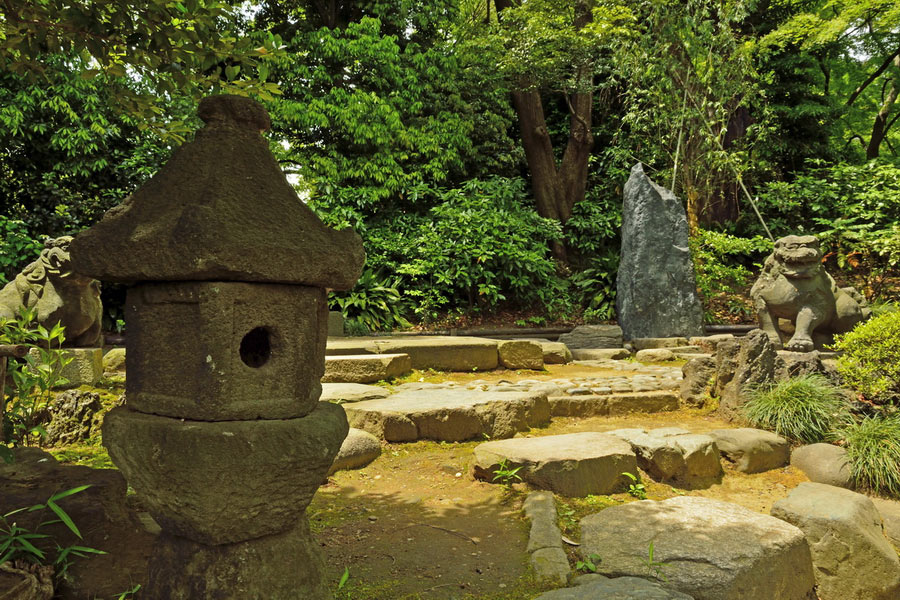
Every element in a Japanese garden has a meaning, and a lantern is no exception. Used only for Buddhist temples originally, they are often seen in Shinto shrines too. The bottom (fire) represents the earth; fu and ka pointing towards the sky represent life's fleetingness.
Water Basins - Tsukubai
Water basins are used for the ritual cleansing of hands and rinsing of the mouth at Buddhist temples, especially before the tea ceremony. Translated as "to bow down," the practice denotes a sense of humility.
Paths and Bridges
Whether made of stone, wood, or logs, the bridge is a symbol of the pathway to a better world after death or paradise. This metaphor first appeared in the Heian period.
The design of paths in stroll and promenade gardens leads visitors to the best viewpoints. Skillfully laid-out paths provide a changing landscape of rocks, water, lanterns, and plants.
Asymmetry
A main hallmark of Japanese gardens is imposing no order over nature. For example, ponds and artificial lakes typically have asymmetrical borders. The shapes should be natural – horizontal water, vertical bamboo, and trees.
Borrowed Scenery - Shakkei
Borrowed scenery, or shakkei, is a technique in Japanese gardens where elements outside the garden landscape are incorporated into the design, such as distant mountains, hills, waterfalls, or forests, to create a sense of depth and vastness. Mt. Hiei, seen from the Entsu-ji Temple, is a perfect example of borrowed scenery.
Wabi-sabi
The Ryoan-ji Garden in Kyoto has 15 rocks, but visitors can only see 14 at a time. Is there any meaning behind that? Yes. It's called wabi-sabi – the concept of seeing beauty in imperfect things. While 15 means “perfect”, 14 means “imperfect” in Oriental culture.

